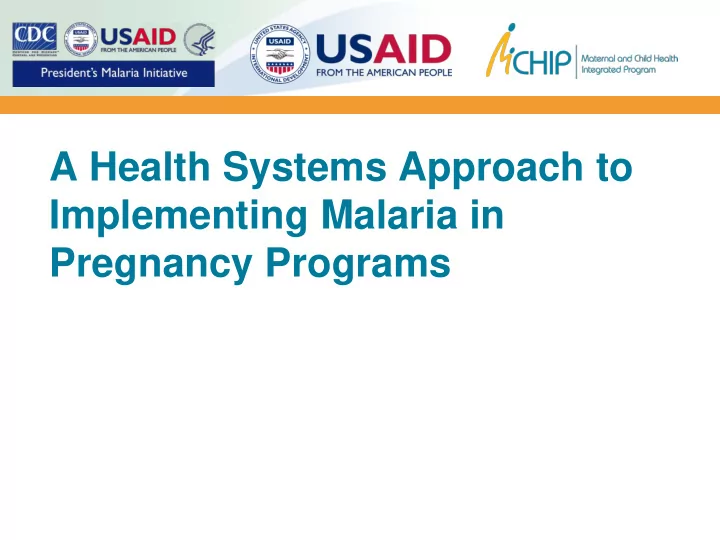

A Health Systems Approach to Implementing Malaria in Pregnancy Programs
Goals and targets for malaria control Roll Back Malaria (RBM) 80% and President’s Malaria Initiative (PMI) 85% targets for coverage of people at risk by 2010 for: Intermittent preventive treatment for pregnant women (IPTp) Use of long lasting Insecticide Treated Nets (ITNs) Diagnosis and treatment of malaria Through 2012, we have still not achieved targets for coverage of pregnant women 2
Most Recent IPTp2 Coverage Data 80 70 70 Percent Coverage 60 60 52 44 47 47 50 45 40 33 36 40 33 32 27 30 25 23 18 20 7 10 5 1 0 From most recent available surveys: DHS, MIS, MICS, 3 NHIS
Most Recent LLIN Coverage Data for Pregnant Women 80 72 71 70 Percent Coverage 60 55 57 60 51 47 50 49 44 46 50 43 43 42 41 40 33 29 26 30 20 20 13 10 10 0 Angola Benin DRC Ethiopia Ghana Guinea Kenya Liberia Madagascar Malawi Mali Mozambique Nigeria Rwanda Senegal Tanzania Zanzibar Uganda Zambia Zimbabwe Average From most recent available surveys: DHS, MIS, MICS, 4 NHIS
Moving targets… (Les cibles mobiles…) Updated Global Malaria Action Plan (GMAP) objectives beyond 2011: Achieve universal access to case management in public sector by end 2013; in private sector by end 2015; to community case management of malaria (in countries where it is an appropriate strategy) by end 2015 Achieve universal access to and use of prevention measures by end 2013; sustained by 2015 and beyond 5
Advancing MIP programming MIP interventions are not one-shot actions Must be delivered as part of comprehensive focused antenatal care (FANC) Eight essential program components that are needed to put MIP policy into practice While each component is distinct, they are inter-related; when one is weak, other components can be negatively affected. 6
Core Components of MIP Programming 1. Integration Collaboration among reproductive health, malaria and HIV/AIDS for effective planning Coordination of implementation efforts 2. Health Policy/Guidelines Harmonized: malaria, reproductive health, HIV/AIDS Simple and clear dissemination to health workers 3. Procurement/Commodities Availability of ITNs, SP and RDTs at ANC 7
MIP Program Components, cont’d 4. Quality Assurance Performance standards in place based on national guidelines Linked with supervision support 5. Capacity Building In-service training Pre-service education 6. Community Awareness and Involvement Bridging the link between communities and facilities Promotion of ANC, ITN use, IPTp uptake 8
MIP Program Components, cont’d 7. Monitoring and Evaluation MIP data incorporated into malaria and overall health management information systems and used to assess if expected results are being achieved 8. Financing Advocacy for MIP funding based on the fact that pregnant women are most vulnerable 9
MIP Implementation Components and Stages of Implementation Program Components Stages of Implementation Integration 1. Policy 2. Country has achieved 4 Commodities MIP readiness 3. Country is approaching MIP 3 Quality Assurance 4. readiness Capacity Building 5. Country is developing 2 and testing MIP Community awareness 6. systems & involvement Policy in MIP being 1 Monitoring and 7. or very recently Evaluation formulated Financing 8. 10
MIP program assessments MCHIP conducted three country case studies, looking across the 8 MIP program components, to better understand: Best practices/strategies that have supported MIP programming success; Existing bottlenecks in MIP program implementation and how these are addressed; and Lessons learned that inform future MIP programming. At April 2012 RBM MIP Working Group meeting, program managers from 8 countries used the MIP stages matrix to self-assess and develop individual country MIP updates and action plans 11
Status of MIP Programs: Integration Countries are using FANC platform Services are integrated at facility levels Meetings for coordination between RH and malaria control not regular Partner coordination impacted Vertical funding streams Competition created across MOH units 12
Status: Commodities Stock-outs of SP & ITNs at ANC Inappropriate use of SP to treat cases of malaria Some countries are implementing universal free access to ITNs for pregnant women 13
Status: Quality Assurance MIP performance standards in place QA systems officially include routine supervision and performance assessments QA systems not functioning due to Lack of funding Competing priorities 14
Status: Community Involvement, Awareness Community volunteers active in education and mobilization for FANC/MIP Attributed to increasing ITN use by pregnant women More strategies are needed to generate resources from within target communities 15
Recommendations 1. Identify local champions 2. Promote integration and coordination mechanisms at all levels 3. Advocate to overcome commodities problems and ensure adequate and consistent stocks 4. Increase community initiatives to overcome barriers to care-seeking 5. Develop capacity-building through pre-service education, on-the- job-training, mentorship and supervision, group-based in-service training 6. Strengthen quality assurance systems 7. Better coordination and local support for financing 16
Conclusion Stakeholders should review country-level MIP programs from the health systems perspective, considering successes and challenges across all inter-related program components, in order to set MIP program goals and determine actions that will lead to their achievement. 17
Recommend
More recommend